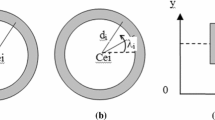Abstract
This article deals with uncertainty and imprecision treatment during the mobile robot localization process. The imprecision determination is based on the use of the interval formalism. Indeed, the mobile robot is equipped with an exteroceptive sensor and odometers. The imprecise data given by these two sensors are fused by constraint propagation on intervals. At the end of the algorithm, we get 3D localization subpaving which is supposed to contain the robot’s position in a guaranteed way. Concerning the uncertainty, it is managed through a propagation architecture based on the use of the Transferable Belief Model of Smets. This architecture enables to propagate uncertainty from low level data (sensor data) in order to quantify the global uncertainty of the robot localization estimation.
Similar content being viewed by others
References
Atiya, S., & Hager, G. D. (1993). Real-time vision-based robot localization. IEEE Transactions on Robotics and Automation, 9(6), 785–800.
Burgard, W., Fox, D., Moors, M., Simmons, R., & Thrun, S. (2000). Collaborative multi robot exploration. In Proceedings of IEEE international conference on robotics and automation, San Francisco.
Chung, H., Ojeda, L., & Borenstein, J. (2001). Sensor fusion for mobile robot dead-reckoning with a precision-calibrated fiber optic gyroscope. In Proceedings of IEEE international conference on robotics and automation, Seoul, Korea (pp. 3588–3593).
Clerentin, A., Pegard, C., & Drocourt, C. (1999). Environment exploration using an active vision sensor. In Proceedings of the IEEE international conference on intelligent robots and systems (IROS’99), Coree, October (pp. 1525–1530).
Clerentin, A., Delahoche, L., & Brassart, E. (2001). Omnidirectional sensors cooperation for multi-target tracking. In Proceedings of IEEE international conference on multisensor fusion and integration for intelligent systems, Baden-Baden, Germany.
Clerentin, A., Delahoche, L., Brassart, E., & Cauchois, C. (2002). An uncertainty propagation architecture for the localization problem. In Workshop on performance metrics for intelligent systems PerMIS2002, NIST, Washington, USA.
Clerentin, A., Delahoche, L., Brassart, E., & Drocourt, C. (2003). Uncertainty and error treatment in a dynamic localization system. In Proceedings of the 11th international conference on advanced robotics, Coimbra, Portugal (pp. 1314–1319).
Cox, I. J., & Blanche, X. (1991). An experiment in guidance and navigation of an automous robot vehicule. IEEE Transactions on Robotics and Automation, 7(2), 193–204.
Di Marco, M., Garulli, A., Giannitrapani, A., & Vicino, A. (2004). A set theoretic approach to dynamic robot localization and mapping. Autonomous Robots, 16(1), 23–47.
Dubois, D., & Prade, H. (1988). Representation and combination of uncertainty with belief functions and possibility measures. Computational Intelligence, 4, 244–264.
Fox, D., Burgard, W., & Thrun, S. (1998). Active Markov localization for mobile robots. Robotics and Autonomous Systems, 25(3–4), 195–207.
Garulli, A., & Vincino, A. (2001). Set membership localization of mobile robots via angle measurements. IEEE Transactions on Robotics and Automation, 17, 450–463.
Hanebeck, U. D., & Schmidt, G. (1996). Set theoretic localization of fast mobile robots using an angle measurement technique. In Proceedings of IEEE international conference on robotics and automation, Minneapolis, USA (pp. 1387–1394).
Jaulin, L., Braems, I., Kieffer, M., & Walter, E. (2001a). Nonlinear state estimation using forward-backward propagation of intervals in an algorithm. In Scientific computing, validated numerics, interval methods (pp. 191–204). Dordrecht: Kluwer Academic.
Jaulin, L., Kieffer, M., Didrit, O., & Walter, E. (2001b). Applied interval analysis. London: Springer.
Julier, S.J., & Uhlmann, J.K. (2001). A counter example to the theory of simultaneous localization and map building, In Proceedings of IEEE international conference on robotics and automation, Seoul (pp. 4238–4243).
Leonard, J., & Durrant-Whyte, H. (1991). Mobile robot localization by tracking geometric beacons. IEEE Transactions on Robotics and Automation, 7(3), 89–97.
Meizel, D., Leveque, O., Jaulin, L., & Walter, E. (2002). Initial localization by set inversion. IEEE Transactions on Robotics and Automation, 18(6), 966–971.
Milanese, M., Norton, J., Piet-Lahanier, H., & Walter, E. (Eds.). (1996). Bounding approaches to system identification. New York: Plenum.
Moore, R. E. (1979). Methods and applications of interval analysis. Philadelphia: SIAM.
Murphy, R. (1998). Dempster-Shafer theory for sensor fusion in autonomous mobile robots. IEEE Transactions on Robotics and Automation, 14(2), 197–206.
Rombaut, M. (1998). Decision in multi-obstacle matching process using Dempster-Shafer theory. In Proceedings of the conference advances in vehicle control and safety, Amiens, France (pp. 63–68).
Rombaut, M. (2001). Sur l’utilisation de la théorie de l’évidence pour la perception et la fusion de données. Presentation on GDR ISIS 2001, ENST, Paris, France.
Roumeliotis, S., & Rekleitis, I. (2003). Analysis of multirobot localization uncertainty propagation. In IEEE/RSJ international conference of intelligent robots and systems (IROS 2003), Las Vegas, USA.
Royère, C., Gruyer, D., & Cherfaoui, V. (2000). Data association with belief theory. In 3rd international conference on information fusion, FUSION 2000, Paris, France.
Sabater, A., & Thomas, F. (1991). Set-membership approach to the propagation of uncertain geometric information. In Proceedings of IEEE international conference on robotics and automation (Vol. 3, pp. 2806–2811) Sacramento, USA.
Shafer, G. A. (1976). A mathematical theory of evidence. Princeton: Princeton University Press.
Shamma, J. S., & Tu, K.-Y. (1997). Approximate set-valued observers for nonlinear systems. In IEEE transactions on automatic control, May 1997 (pp. 648–658).
Smets, Ph. (1998). The transferable belief model for quantified belief representation. Handbook of defeasible reasoning and uncertainty management systems (pp. 267–301). Dordrecht: Kluwer Academic.
Thrun, S. (2003). Learning occupancy grid maps with forward sensor model. Autonomous Robot, 15, 111–127.
Thrun, S., Burgard, W., & Fox, D. (1998). A probabilistic approach to concurrent mapping and localization for mobile robot. Machine Learning, 31(5), 1–25.
Thrun, S., Fox, D., Burgard, W., & Dellaert, F. (2001). Robust Monte Carlo localization for mobile robots. Artificial Intelligence, 128(1–2), 99–141.
Author information
Authors and Affiliations
Corresponding author
Rights and permissions
About this article
Cite this article
Clérentin, A., Delafosse, M., Delahoche, L. et al. Uncertainty and imprecision modeling for the mobile robot localization problem. Auton Robot 24, 267–283 (2008). https://doi.org/10.1007/s10514-007-9066-3
Received:
Accepted:
Published:
Issue Date:
DOI: https://doi.org/10.1007/s10514-007-9066-3




